A Guide to Growing the Best Figs in Your Own Garden
Published: November 22, 2025 at 10:52:12 PM UTC
There's something magical about biting into a perfectly ripe fig you've grown yourself. These sweet, juicy fruits with their unique texture and flavor have been cultivated for thousands of years, and for good reason. Growing figs at home is not only rewarding but surprisingly accessible for most gardeners. Whether you have a spacious backyard or just a sunny patio, you can successfully grow these delectable fruits with the right knowledge and care.

In this comprehensive guide, we'll walk you through everything you need to know about growing figs, from selecting the right varieties for your climate to harvesting and preserving your bounty. With some basic guidelines and a little patience, you'll be enjoying your own homegrown figs before you know it.
Benefits of Growing Your Own Figs
Before diving into the how-to, let's explore why growing your own figs is worth the effort:
- Figs are packed with nutrients including fiber, potassium, calcium, and vitamins A, B, and K
- Home-grown figs taste significantly better than store-bought ones, as they can be harvested at peak ripeness
- Fig trees are relatively low-maintenance compared to many other fruit trees
- They can be grown in containers, making them suitable for small spaces
- Fig trees can be decorative additions to your landscape with their distinctive leaves
- Many varieties can produce two harvests per year in suitable climates
- Fresh figs have a very short shelf life, making them expensive and hard to find commercially
Best Fig Varieties for Home Gardens
With thousands of fig varieties worldwide, choosing the right one for your garden can seem overwhelming. Here are seven popular varieties well-suited for home gardens across different growing zones:
Celeste (Sugar Fig)
Cold hardy. Small to medium-sized figs with light purple to brown skin and sweet red flesh. Excellent for fresh eating with a honey-like sweetness. One of the most cold-hardy varieties, suitable for zones 6-10. Performs well in humid climates.
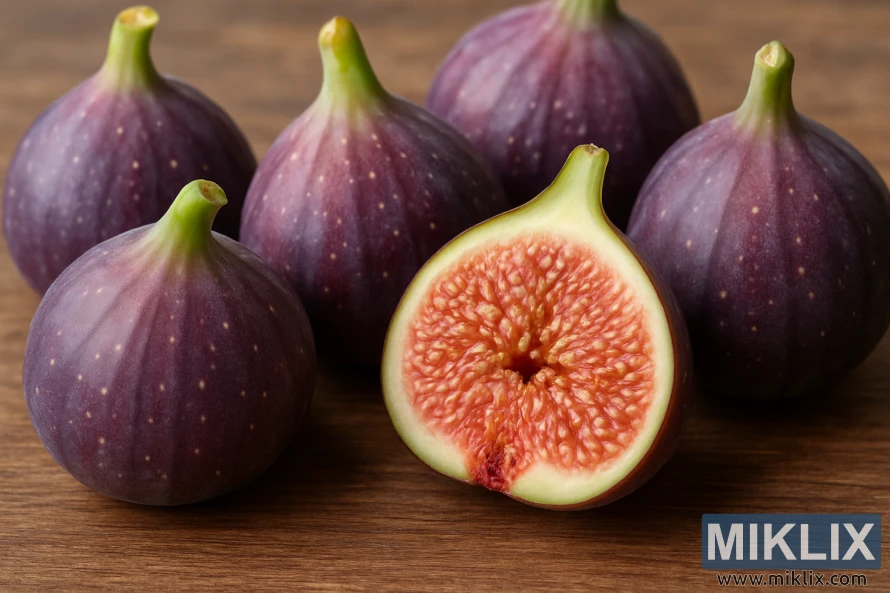
Brown Turkey
Reliable producer. Medium-sized figs with bronze skin and amber flesh. Moderately sweet flavor, excellent for preserving. Very reliable producer that can bear fruit on new growth even after winter damage. Adaptable to zones 7-10.

Chicago Hardy
Cold hardy. Small to medium purple-skinned figs with dark red flesh. Sweet, balanced flavor with earthy notes. Extremely cold-hardy (can survive to zone 5 with protection). Will often produce a crop even if winter-killed to the ground.
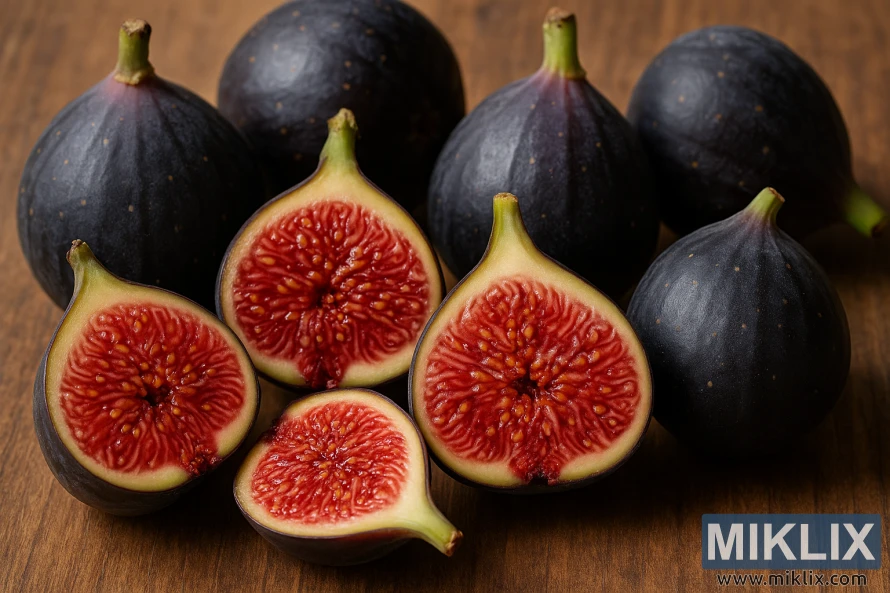
Black Mission
Classic flavor. Medium-sized figs with deep purple (almost black) skin and strawberry-red flesh. Rich, sweet flavor with berry notes. Best for zones 7-11, preferring hot, dry climates but adaptable to areas with mild summers.
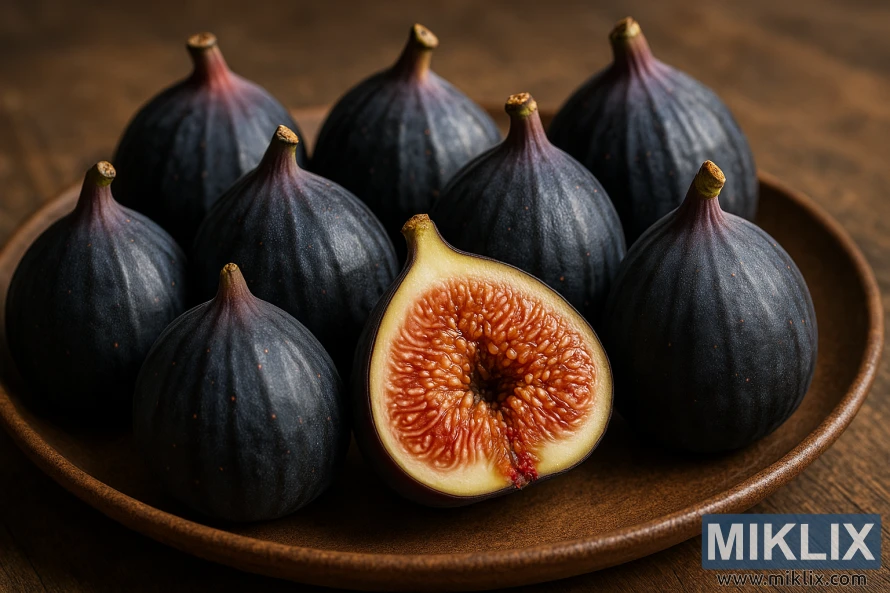
Kadota
Excellent for preserving. Medium greenish-yellow figs with amber flesh. Mild, sweet flavor with honey notes. Excellent for canning and preserving due to thick skin. Adaptable to zones 7-10, performs well in hot, dry climates.
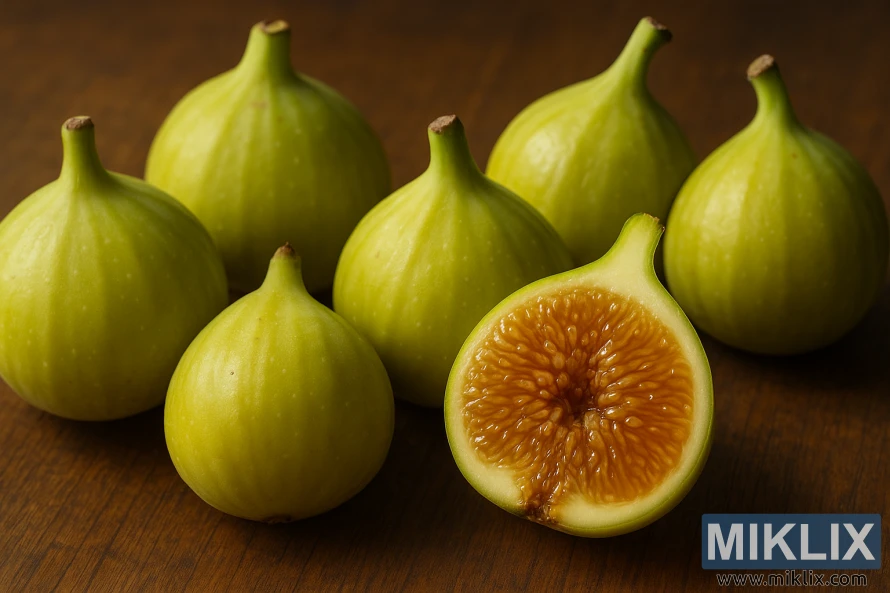
Adriatic
High sugar content. Medium light green to yellowish figs with bright strawberry-red flesh. Very sweet with high sugar content, often used for fig paste and dried figs. Suitable for zones 7-10, prefers Mediterranean-like conditions.
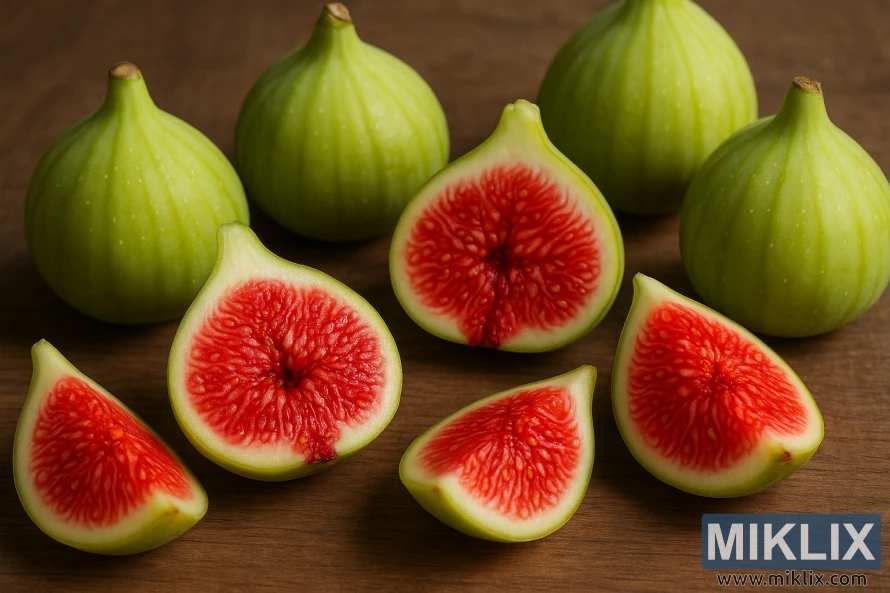
Climate and Soil Requirements
Climate Considerations
Figs are native to Mediterranean regions, which gives us clues about their preferred growing conditions:
- Most fig varieties thrive in USDA hardiness zones 7-10, though some cold-hardy varieties can survive in zone 5-6 with protection
- Figs need plenty of sunlight – at least 6-8 hours of direct sun daily for optimal fruit production
- They can tolerate temperatures from 15°F to 110°F (-9°C to 43°C), but fruit quality suffers at extremes
- In colder regions, plant figs against a south-facing wall to provide warmth and protection
- In hot climates, some afternoon shade can prevent leaf scorch during intense summer heat

Soil Requirements
The right soil conditions are crucial for healthy fig trees and abundant harvests:
- Figs prefer well-draining soil with a pH between 6.0 and 6.5
- They can tolerate a wide range of soil types but perform best in loamy soil
- Good drainage is essential – figs hate "wet feet" and can develop root rot in waterlogged conditions
- In areas with heavy clay soil, consider planting in raised beds or mounds
- Before planting, incorporate organic matter like compost to improve soil structure and fertility
- Avoid planting in areas with known root-knot nematode problems, as these can severely damage fig trees
Pro Tip: If you're unsure about your soil quality, consider getting a soil test through your local extension office. This will help you identify any nutrient deficiencies or pH issues that need correction before planting.
Step-by-Step Planting Instructions
Container Planting
Growing figs in containers is ideal for small spaces or colder climates where trees need to be moved indoors for winter:
- Choose the right container: Select a pot at least 15-20 inches in diameter with good drainage holes. Young trees (1-2 years) can start in 3-5 gallon pots, while mature trees need 10-15 gallon containers or larger.
- Prepare the potting mix: Use a high-quality, well-draining potting mix. Add 20-30% perlite or pumice to improve drainage. Avoid regular garden soil in containers.
- Position the tree: Place the tree in the container so the top of the root ball sits about 1 inch below the pot rim to allow for watering.
- Fill and water: Fill around the root ball with potting mix, gently tamping down to remove air pockets. Water thoroughly until water drains from the bottom.
- Mulch: Add a 1-2 inch layer of mulch on top of the soil, keeping it away from the trunk to prevent rot.

Ground Planting
For those with adequate space and suitable climate, planting figs directly in the ground allows them to reach their full potential:
- Choose the location: Select a spot with full sun (minimum 6-8 hours daily) and protection from strong winds. In colder regions, a south-facing wall provides additional warmth.
- Spacing: Plant fig trees 10-15 feet apart if growing in bush form, or 15-20 feet apart for tree form. Allow at least 20 feet from buildings to prevent root damage.
- Prepare the hole: Dig a hole twice as wide as the root ball and about the same depth. Loosen the soil at the bottom and sides of the hole.
- Plant the tree: Position the tree so it sits 2-4 inches deeper than it was in the nursery pot to encourage low branching. For bare-root trees, create a small mound in the hole center and spread the roots over it.
- Backfill: Fill the hole with soil, gently firming it around the roots. Water thoroughly to settle the soil and eliminate air pockets.
- Mulch: Apply a 2-4 inch layer of organic mulch in a circle around the tree, keeping it a few inches away from the trunk.
When to Plant: The best time to plant fig trees is in early spring after the danger of frost has passed. In warmer climates (zones 8-10), fall planting is also suitable, giving the tree time to establish roots before the next growing season.
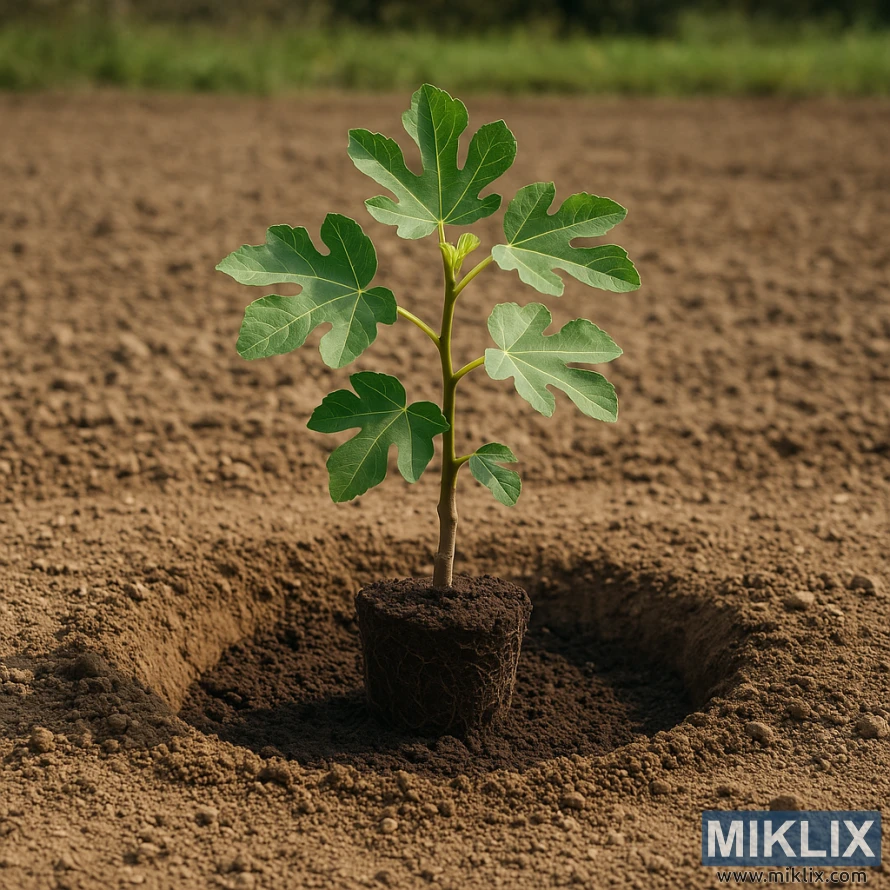
Seasonal Fig Tree Care Calendar
| Season | Pruning | Fertilizing | Watering | Special Care |
| Spring (March-May) | Remove dead or damaged wood. For established trees, prune to maintain size and shape before leaf emergence. | Apply balanced fertilizer (8-8-8 or 10-10-10) when new growth begins. For young trees, use 1-2 oz per application. | Resume regular watering as soil warms. Keep soil consistently moist but not soggy. | Uncover protected trees in cold regions. Watch for new growth. Apply mulch around base. |
| Summer (June-August) | Pinch tips of new growth to encourage branching. Remove suckers from base. | Second light application in mid-June for young trees. Avoid fertilizing after July to prevent late growth. | Water deeply 1-2 times weekly depending on rainfall. Increase during fruit development and hot periods. | Watch for first crop (breba) in early summer. Maintain 2-4 inch mulch layer. Monitor for pests. |
| Fall (September-November) | Minimal pruning. Remove any remaining fruit after harvest. | No fertilizer needed. Adding compost around base is beneficial. | Gradually reduce watering as temperatures cool. Allow soil to dry more between waterings. | Harvest main crop. Begin preparing container plants for winter in colder regions. |
| Winter (December-February) | Major pruning in late winter during dormancy. Remove crossing branches and thin for air circulation. | No fertilizer needed. | Minimal watering for ground plants. For container plants, water sparingly only when soil is dry. | In zones 5-7, protect trees with burlap, mulch, or move containers to unheated garage or basement. |
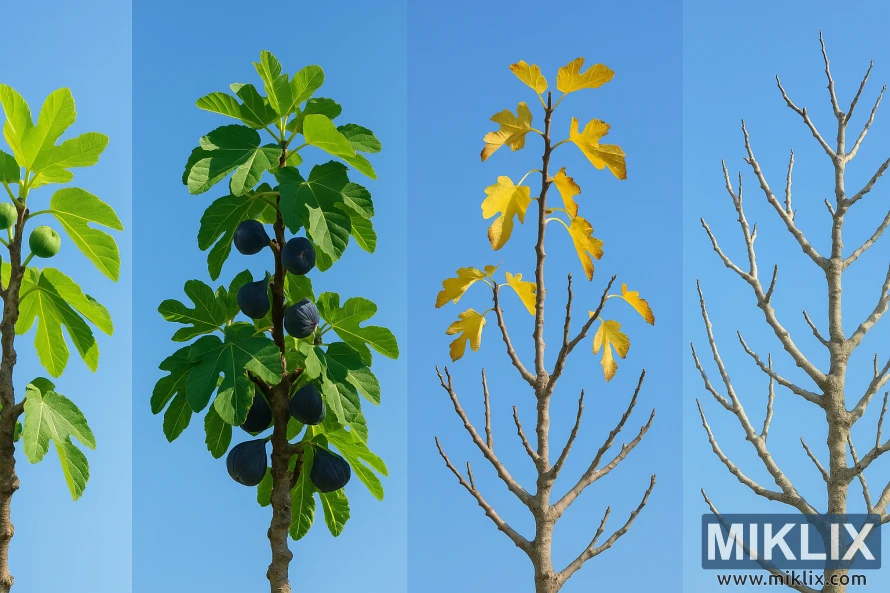
Training and Pruning Fig Trees
Figs can be trained in either bush or tree form, with bush form being more practical in most home gardens, especially in colder regions:
Bush Form
- Encourages multiple stems from ground level
- More cold-hardy as new shoots can emerge if upper growth is damaged
- Fruit is easier to reach for harvesting
- Begin training at planting by cutting back the young tree by one-third
- Select 3-8 strong, well-spaced stems as leaders and remove others
Tree Form
- Single trunk with branches starting 1-2 feet above ground
- Better for warmer regions (zones 8-10) where winter damage is minimal
- Creates a more traditional tree appearance in the landscape
- Maintain by removing suckers from the base
- Prune to maintain an open center for light penetration
Common Fig Pests and Diseases
While figs are relatively pest and disease resistant compared to many fruit trees, they can still face several challenges. Here's how to identify and address common problems using organic methods.
Common Pests
| Pest | Signs | Organic Control Methods |
| Fig Beetles | Large green beetles feeding on ripe fruit, creating large holes | Harvest fruit promptly when ripe. Use yellow sticky traps. Apply beneficial nematodes to soil to control larvae. |
| Root-Knot Nematodes | Stunted growth, yellowing leaves, galls on roots | Plant in nematode-free soil. Add organic matter to soil. Consider resistant rootstocks. Apply neem cake to soil. |
| Ants and Wasps | Insects feeding on ripe fruit | Harvest promptly. Use ant barriers on tree trunks. Cover individual fruits with paper bags. |
| Scale Insects | Small bumps on stems and branches, sticky honeydew | Apply horticultural oil in dormant season. Introduce ladybugs as natural predators. |
Common Diseases
| Disease | Symptoms | Organic Treatment |
| Fig Rust | Yellow-brown spots on leaves, premature leaf drop | Remove and destroy fallen leaves. Improve air circulation through pruning. Apply organic copper fungicide early in season. |
| Root Rot | Wilting despite adequate water, yellowing leaves, stunted growth | Improve drainage. Reduce watering frequency. For container plants, repot with fresh, well-draining soil. |
| Fig Mosaic Virus | Mottled, discolored leaves with yellow spots | No cure available. Remove severely infected trees. Control fig mite vectors with insecticidal soap. |
| Fruit Souring | Fermented smell, liquid oozing from eye of fruit | Harvest promptly when ripe. Choose fig varieties with closed eyes. Remove affected fruit immediately. |
Prevention is Key: Many fig problems can be prevented through proper cultural practices. Ensure adequate spacing between trees for air circulation, avoid overhead watering, maintain proper nutrition without over-fertilizing, and clean up fallen fruit and leaves promptly.
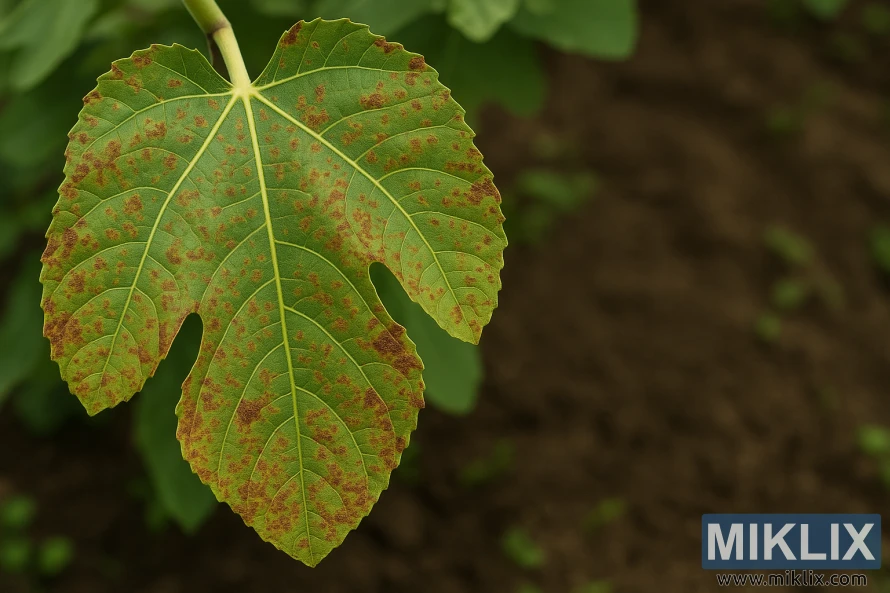
Harvesting Techniques and Ripeness Indicators
Knowing when and how to harvest figs is crucial for enjoying them at their peak flavor. Unlike many fruits, figs don't continue to ripen once picked, so timing is everything.
How to Tell When Figs Are Ripe
- Softness: The most reliable indicator is a soft, yielding texture when gently squeezed. Focus on the neck of the fig (where it attaches to the stem) – when this area softens, the fig is ready.
- Drooping: Ripe figs often hang down rather than pointing upward or outward.
- Color: Depending on the variety, the skin will develop its mature color (purple, brown, green, or yellow).
- Skin texture: The skin may develop small cracks or a wrinkled appearance.
- Size: The fig will reach its full size for the variety.
- Easy release: A ripe fig will detach easily from the branch with gentle pressure.
Proper Harvesting Technique
- Harvest in the morning when temperatures are cooler and sugar content is highest.
- Gently twist the fig where it connects to the stem, or use clean pruning shears for harder-to-reach fruits.
- Handle figs carefully – they bruise easily when ripe.
- Place harvested figs in a shallow container, avoiding stacking which can cause crushing.
- Keep harvested figs out of direct sunlight and process or refrigerate them promptly.
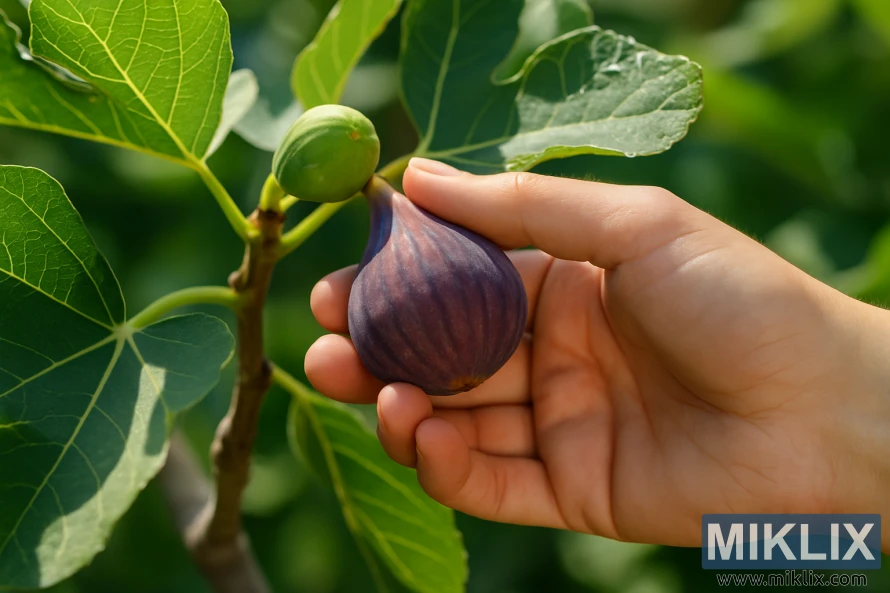
Harvesting Schedule
Fig trees can produce one or two crops per year, depending on the variety and climate:
- Breba crop: Early figs that develop on the previous year's wood. These ripen in early summer (June-July) and are typically fewer in number.
- Main crop: The primary harvest that develops on current season's growth. These ripen in late summer to fall (August-October).
Pro Tip: Check your fig trees daily during ripening season. Figs can go from almost-ripe to overripe in just a day or two, especially during hot weather. Birds and insects are also quick to discover ripe figs, so timely harvesting is essential.
Storage and Preservation Methods
Fresh figs are highly perishable, lasting only 1-2 days at room temperature or 5-7 days in the refrigerator. To enjoy your harvest year-round, consider these preservation methods:
Short-Term Storage
- Store unwashed figs in a single layer in a shallow container lined with paper towels
- Refrigerate at 36-40°F (2-4°C) for up to one week
- Bring to room temperature before eating for best flavor
- Wash only right before consuming to prevent mold
Freezing Figs
- Wash figs gently and pat dry
- Remove stems and cut in half if desired
- Place on a baking sheet in a single layer and freeze until solid (about 3 hours)
- Transfer to freezer bags or containers, removing as much air as possible
- Label with date and store for up to 10-12 months
- Use frozen figs in smoothies, baking, or thaw for toppings
Drying Figs
Dried figs concentrate the sweetness and can be stored for months:
Sun Drying
- Cut figs in half and place cut-side up on screens
- Cover with cheesecloth to protect from insects
- Place in direct sun for 3-4 days, bringing indoors at night
- Figs are done when leathery but still slightly pliable
Dehydrator Method
- Cut figs in half and arrange on dehydrator trays
- Dry at 135°F (57°C) for 8-12 hours
- Check periodically for desired texture
- Store in airtight containers in a cool, dark place
Preserving in Syrup or Jam
Fig preserves are delicious and versatile:
- Fig jam: Cook chopped figs with sugar, lemon juice, and spices until thickened
- Preserved in syrup: Simmer whole or halved figs in sugar syrup with complementary flavors like vanilla, cinnamon, or honey
- Can using proper water bath canning techniques for long-term storage
- Refrigerator preserves will last 2-3 weeks without canning
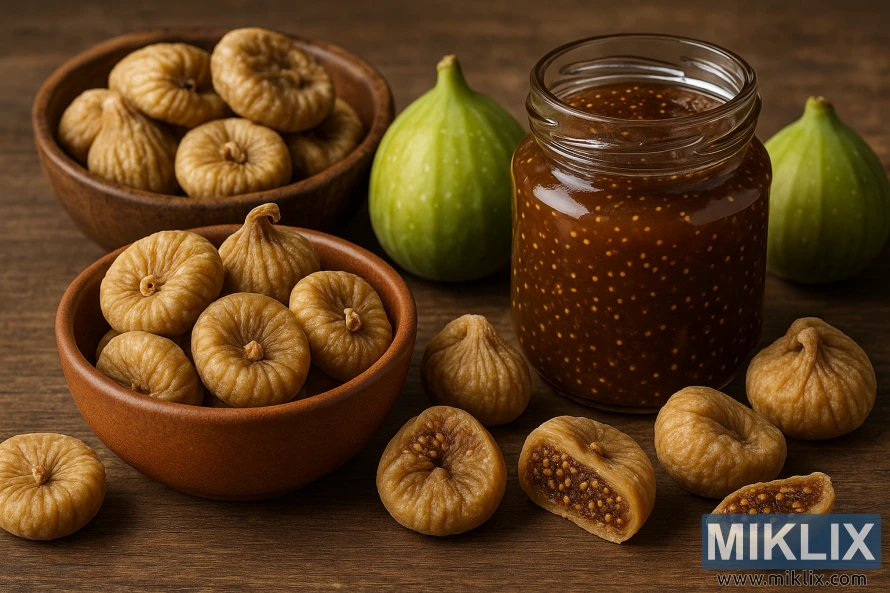
Troubleshooting Common Fig Growing Problems
Common Problems
- Figs not ripening: Insufficient sunlight, cool temperatures, or young tree not yet mature enough to produce quality fruit.
- Fruit dropping before ripening: Water stress (too much or too little), excessive nitrogen fertilizer, or variety may require pollination.
- Yellowing leaves: Overwatering, nutrient deficiencies, or pest problems like nematodes.
- Poor growth: Insufficient sunlight, poor soil conditions, or container that's too small.
- Winter damage: Cold temperatures damaging branches in zones 5-7.
Solutions
- For unripe figs: Ensure 6-8 hours of direct sunlight. Be patient with young trees (may take 3-4 years to produce quality fruit).
- For fruit drop: Maintain consistent soil moisture. Reduce nitrogen fertilizer. Verify your variety is suitable for your climate.
- For yellow leaves: Check drainage and adjust watering. Apply balanced fertilizer. Test for nematodes.
- For poor growth: Relocate to sunnier spot if possible. Improve soil with compost. Repot container plants.
- For winter protection: Wrap trunk with burlap, mulch heavily, or use specialized fig tree covers in cold zones.
Reviving a Struggling Fig Tree
If your fig tree is struggling, these steps can help bring it back to health:
- Assess the damage: Determine if the problem is environmental, pest-related, or disease-related.
- Prune damaged areas: Remove dead or diseased branches back to healthy wood.
- Check the roots: For container plants, gently remove from the pot to inspect for root binding or rot.
- Adjust care routine: Modify watering, fertilizing, or sun exposure based on symptoms.
- Rejuvenation pruning: For severely neglected trees, consider cutting back to 1-2 feet above ground in early spring to stimulate fresh growth.

Frequently Asked Questions About Fig Cultivation
How long does it take for a fig tree to bear fruit?
Most fig trees begin producing fruit within 2-3 years after planting. However, the first crops may be small and the fruit quality improves as the tree matures. Trees grown from cuttings often fruit faster than those grown from seedlings. Some varieties like 'Celeste' and 'Brown Turkey' tend to fruit earlier than others.
Can I grow figs in cold climates?
Yes, with proper protection. In zones 5-6, choose cold-hardy varieties like 'Chicago Hardy' or 'Celeste' and provide winter protection. Options include wrapping the tree in burlap and straw, using specialized fig tree covers, or growing in containers that can be moved to an unheated garage or basement during winter (ideal temperature 25-40°F). Some growers in cold regions use the "trench and bury" method, where the tree is laid down in a trench and covered with soil for winter.
Why are my figs splitting open before they're ripe?
Fig splitting is usually caused by fluctuations in soil moisture, particularly when dry conditions are followed by heavy rain or irrigation. To prevent splitting, maintain consistent soil moisture through regular watering and mulching. Some varieties are more prone to splitting than others, especially during periods of high humidity followed by rain.
Do fig trees need a pollinator?
Most common fig varieties grown in home gardens are self-fertile and don't require pollination. These are known as "common figs" and include popular varieties like 'Brown Turkey', 'Celeste', and 'Chicago Hardy'. Some specialized types (Smyrna and San Pedro figs) do require pollination by a specific wasp that cannot survive in most North American climates, so these aren't recommended for home gardeners.
How do I propagate fig trees?
The easiest method is through hardwood cuttings taken in late winter. Select 8-10 inch sections of 1-year-old wood, plant them in well-draining soil with only the top bud exposed, and keep the soil consistently moist. Rooting should occur within 4-8 weeks. Fig trees can also be propagated through air layering or by rooting leafy cuttings under mist during the growing season.
Conclusion
Growing figs in your home garden can be an incredibly rewarding experience. With their relatively low maintenance needs, adaptability to different growing conditions, and incomparable fresh-picked flavor, figs deserve a place in any gardener's landscape. Whether you're growing them in containers on a patio or as specimen trees in your yard, the basic principles remain the same: provide adequate sunlight, well-draining soil, consistent moisture, and appropriate winter protection for your climate.
Remember that patience is key with fig trees. They may take a few years to reach their full productive potential, but the wait is well worth it when you bite into that first perfectly ripe, homegrown fig. By following the guidelines in this comprehensive guide, you'll be well on your way to fig-growing success. Happy gardening!
Further Reading
If you enjoyed this post, you may also like these suggestions:
- How to Grow Peaches: A Guide for Home Gardeners
- The Best Fruit Trees to Plant in Your Garden
- The Best Strawberry Varieties to Grow in Your Garden
